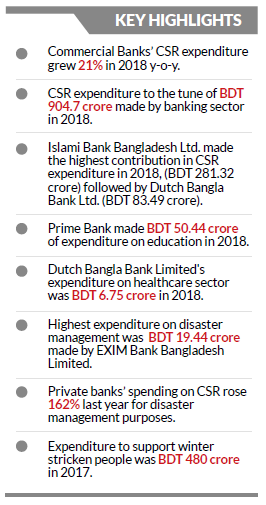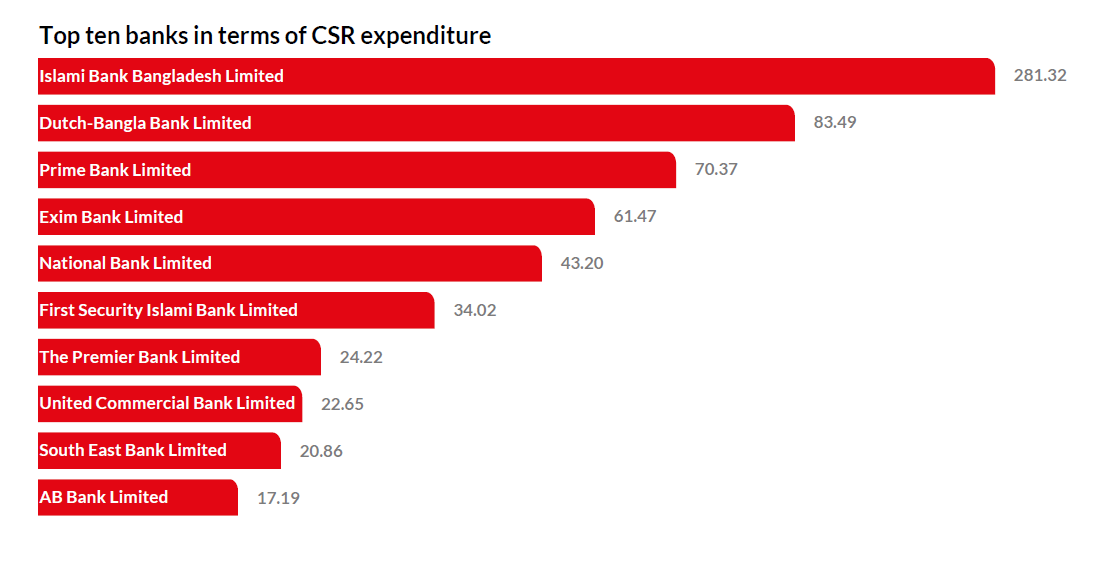Corporate Social Responsibility, an approach towards inclusive and sustainable banking
In 2019, most of the corporations across the globe are seemingly to transform itself into “purpose-driven company”.
More than ever before, businesses are feeling the pressure to define their purpose and communicate it to their customers- which is not at all a bad thing. Consumers today are not making decisions solely based on products or price. They are evaluating how a company acts and how it represents its values.In Accenture Strategy’s global survey of almost 30,000 consumers, 62% say they want companies to take a stand on issues like sustainability, transparency or fair employment in a way that aligns with their own beliefs. However, it is discerned that most companies, even those with good intentions, get purpose all wrong by approaching it as a one-time Corporate Social Responsibility (CSR) program.
Corporate Social Responsibility: Creating a shared purpose
Companies, particularly Financial Institutions have their core principle embedded in profit maximization mechanism. Then the question arises that besides profit maximization, why companies are also putting their focus on creating value for the people and community? According to a global data, companies can take actions that both boost profits and improve economic and social conditions for their local communities. Therefore, prior venturing into a CSR project, a company must ask itself two pertinent questions: How they are making people’s lives better and engaging their customers to be part of it?
Modern managers are now perceiving integration of CSR into their strategy as a source of competitive advantage. Generation Z (those born in the mid-1990s) are now entering the formal job market, earning and spending money. They prefer companies that oppose poverty and support green policies and human rights. The companies that fit into this criteria have developed “purpose brands”- brands that tell clients that they fulfil a social purpose. These clients are a segment called “belief-driven buyers”, who buy brands that stand for something.
Solving a social problem with scale is the way of committing to CSR. Earlier, CSR often revolved around making a donation to a philanthropic organization to support activities, which doesn’t solve social problems with scale. Even still it is the use-case of CSR in many organizations.While one-off philanthropic ventures are important but, it is good if they last for three years addressing a social/environmental problem in a sustainable way.
We are entering an increasingly unstable environment where a growing number of CSR projects are crisscrossing the path of businesses. In a briefing to a creative agency, Hewlett-Packard indicated that greater diversity in its advertising led to an increase in sales. Ikea has announced that starting in 2020 it will only use recycled wood.
How companies across the globe are committed to social calling?
Globally companies are starting to care more about CSR initiatives in a bid to create an impact towards the community and get close to their customers. Among the largest 250 companies in the world, 92% produced a CSR report in 2015, informing shareholders and the public about the firm’s activities. Globalcompanies are focusing on sustainability initiatives, corporate foundations, employee volunteer programs, and donations to charity etc.
The Global Alliance for Banking on Values (GABV) is a network of banking leaders from around the world committed to advancing positive change in the banking sector. Following the 2008 financial crisis, banks that put people before profit have gained recognition and are growing in strength and number. The GABV calls these banking institutions sustainability-focused banks. They ensure that banking is a healthy and productive system of society and develop a positive, viable alternative to the current banking system.
India is the first country in the world to make CSR mandatory for corporations. Businesses can invest their profits in areas such as education, poverty, gender equality, and hunger.InFY16, India witnessed a 28% growth in CSR spending in comparison to the previous year. In 2017 and 2018 India’s spends further rose with corporate firms aligning their initiatives with new government programs such as Swachh Bharat (Clean India) and Digital India. Along with those projects, education and healthcare is also highly prioritized in India to foster inclusive growth.
Yes Bank, India’s fifth largest private sector bank is the only Greenfield Bank awarded by the Reserve Bank of India in the last two decades.The bank is acclaimed much for it’s commitment towards sustainable environmental On the occasion of Agreement at Paris on global movement towards a low carbon growth pathway, YES Bank donated USD 5 Billon by 2020 towards low carbon infrastructure development in India. They are also working on funding of 5,000 MW of clean energy, increasing percentage of renewable energy of India, contribute towards creating a carbon sink by planting two million trees, ensuring safe and clean drinking water.

Adoption of CSR in Banking Sector of Bangladesh
Over the past few years, CSR has become an integral part of the banking sector of Bangladesh as more and more banks are setting their footprint in the realm of CSR.Banks are now getting actively engaged in socially responsible business operation because of the increasing rate of lending to under-served economic sectors like agriculture and SMEs for faster poverty eradication. The banking sector of Bangladesh has a long history of involvement in charity and donation for poor people, city beautification, religious institution, art and culture of the country.
In 2007, huge investments were being made by several banks in the field of disaster relief. In June 2008, Bangladesh bank guidance suggested that banks could begin reporting their CSR initiatives in modest way as supplement to usual annual financial report, eventually to develop into comprehensive report in GRI format. Information on CSR expenditures have also made available in annual reports of bank.Bangladesh bank initiated the CSR campaign in the financial sector that inspired the CSR engagement of banks.
In 2009, education and health sectors were getting more attention and considered as the most popular area for CSR activity. A few banks introduced interest free educational loan to poor and meritorious students struggling to bear educational expenditures. Several banks have created non-profitable foundations and NGOs to facilitate the cause of charity, donation and other investments as the promotion of CSR activities. Bangladesh Bank has been supporting government’s efforts for society by financing underserved farm and non-farm SMEs and other innovative niche area entrepreneurs.
National Board of Revenue (NBR) is providing tax exemption on the expenditure made by corporatesfor CSR activities from 2011. Any company will get exemption of Income Tax at the rate of 10% foractual cost/ money expended in Corporate Social Responsibility. It will not be applicable for the amount expended in excess of 20% of gross income of the company or BDT 8 crore whichever is lower.

What are the viable areas of CSR expenditure for Financial Institutions?
The business of banking has a direct impact on the environment through consumption of paper, energy, waste management and means of transport used. Bank can reduce this direct environmental impact through limiting the consumption of energy and paper, ensuring good waste management and requiring suppliers’ to conform to environmental standards. In recent times, Bangladesh banking sector has been actively participated various social activities but these efforts are hardly recognized as most of the financial institutions have not integrated CSR in their operation. All of these may be considered as occasional charity or promotional activities.
Bangladesh Bank will monitor CSR adoption and CSR performance of banks and financial institutions, as an additional dimension of their management performance. Bangladesh Bank also had the opportunity to provide a sense of direction to the CSR agenda of the banking sector when it suggested that, banks which are taking measures for rehabilitating, agriculture, fisheries, livestock, and protecting environment, will be considered as more compliant of Corporate Social Responsibility besides providing relief to the people affected in natural calamities.
In broader sense, Financial Institutions can consider four areas of CSR expenditure, as per the guideline of Bangladesh Bank:
 Education
Education
 Health
Health
![]() Environment
Environment
 Extended Responsibilities
Extended Responsibilities
Commercial Banks in Bangladesh responding to CSR initiatives
Financial Institutions are now more keen to participate in CSR initiatives than ever. In 2018, CSR expenditure by commercial banks grew to BDT 904.7 crore, registering 21% growth y-o-y. In this competitive banking environment, CSR is now being perceived as a way to be the ultimate financial partner to the community and people. In terms of CSR initiatives and expenditure, Dutch Bangla Bank Limited is put at the helm of the commercial banks and deemed as pioneer in this area. The bank, which has the second highest CSR expenditure in 2018, made commendable contribution towards education sector. In 2018, they awarded scholarships to 3,031 meritorious and underprivileged students who passed S.S.C examination and equivalents. Since 1997, the bank has been providing scholarship to HSC and graduation level and awarded the stipend to 53,710 students, as of 2018.
Bank Asia accomplished pilot project with Swisscontact and Metlife Foundation for financial inclusion of RMG workers. Under this platform, 3750 numbers of RMG workers have received financial literacy and 650 numbers of accounts have been opened for RMG workers.
Green Delta Life Insurance began a pilot project on weather index-based crop insurance in 2016 in collaboration with International Finance Corporation (IFC). The project ran in nine locations, insuring closeto 10,000 farmers in seven crops. This project showcases a good example of how sustainable CSR initiative for a community can be turned into business model.

Monthly Business Review- June 2019
More sustainable CSR initiatives in the offing
Corporate Social Responsibility (CSR) and sustainability have been at the forefront of most companies’ agendas for quite some time- it is no longer a “nice to have” but a “need to have.” The fact that millennial have a high level of social awareness and they are entering into the formal job market, gives most corporations solid reason to be “purpose-driven”. Giant corporations like Google, Microsoft are deemed as the world’s most reputable companies for CSR activities. Having said that, Financial Institutions are coming in the front row in the realm of CSR and sustainability.
In Bangladesh, the banking sector is embracing a bunch of initiatives to address social/environmental issues. IDLC CSR Guideline confers to International Standards and has maintained signatory membership status with both United Nations Global Compact (UNGC) and United Nations Environment Programme Finance Initiative (UNEPFI) since 2011. In the past few years, commercial banks of Bangladesh have witnessed a splendid CSR expenditure in areas of education, health and disaster management. The CSR outlay took a leap in 2018 to BDT 904.7 crore from BDT 743.9 crore in 2017, triggering 21% y-o-y growth. In order to raise the banking sector’s spirit to be engaged in sustainable CSR initiatives, Bangladesh Bank determined some areas of tax exemption related to CSR for Financial Institutions. When that is a good start to make the financial sector more people and community-oriented, it has to be kept in mind that whether these initiatives are bringing infrastructural development for the long term benefit rather than being just a one-off initiative.
Download View